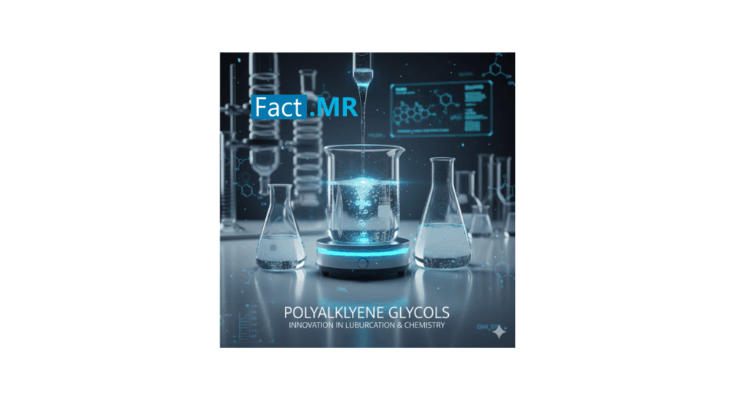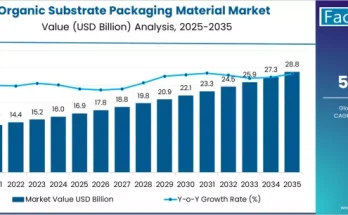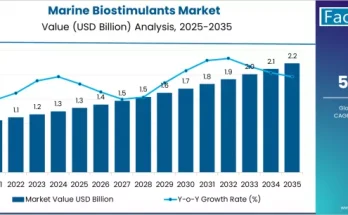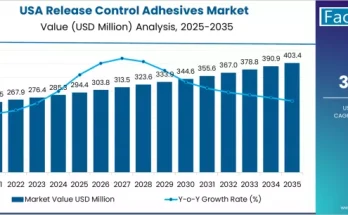The global polyalkylene glycols (PAGs) market is witnessing rapid expansion driven by surging industrial applications, innovations in sustainable materials, and growing adoption across the automotive, personal care, and pharmaceutical sectors. According to a recent report by Fact.MR, the market is projected to rise from USD 2.74 billion in 2024 to USD 6.69 billion by 2034, expanding at an impressive CAGR of 9.3%.
These high-performance polymers—recognized for their thermal stability, water solubility, lubricity, and non-toxic properties—are transforming manufacturing processes and product formulations across multiple industries.
Industrial Expansion and Versatility Fuel Market Momentum
The polyalkylene glycols market has experienced robust growth, increasing from USD 1.75 billion in 2019 to USD 2.54 billion in 2023, reflecting a strong CAGR of 9%. This trajectory is set to continue, supported by the widening scope of PAGs in functional fluids, lubricants, polyurethane foams, and personal care formulations.
The automotive sector remains a key demand driver, where PAG-based lubricants are increasingly preferred for their superior viscosity index and reduced volatility compared to mineral oils. As the global automotive industry pivots toward electric and energy-efficient vehicles, PAGs are emerging as essential ingredients in thermal management fluids and compressor oils, ensuring optimal performance and longevity.
Moreover, PAGs’ unique properties such as oxidative resistance and biodegradability have positioned them as sustainable alternatives in metalworking, hydraulics, and industrial lubrication systems, aligning with tightening global environmental standards.
Personal Care and Pharmaceutical Applications Accelerate Growth
The personal care and cosmetics industry has become a strong growth pillar for the PAGs market. Polyalkylene glycols—especially polyethylene glycols (PEGs)—are used extensively as emulsifiers, humectants, and solvents in skincare, haircare, and cosmetic products. Their mildness, water solubility, and compatibility with natural ingredients make them ideal for next-generation formulations catering to eco-conscious consumers.
In 2024, sales of polyethylene glycols reached USD 828 million, accounting for 30.2% of total market share. With rising disposable incomes and heightened awareness of ingredient safety, the demand for PEGs in premium personal care products is expected to surge through 2034.
In the pharmaceutical industry, polyalkylene glycols play a pivotal role as excipients, drug carriers, and solubilizers, enhancing drug stability and bioavailability. Their use in oral, topical, and parenteral preparations has become integral to modern drug formulation, supporting improved patient outcomes. Furthermore, advances in biomedical engineering are opening new frontiers for PEGs in tissue regeneration and scaffolding materials, underscoring their versatility and market relevance.
Regional Insights: Asia-Pacific Leads Global Growth
The Asia-Pacific region remains at the forefront of the global polyalkylene glycols market, contributing over 26% of total revenue in 2024. Rapid industrialization, expanding automotive production, and robust personal care markets in China, India, and Southeast Asia are fueling demand.
- China, in particular, is poised to grow at a CAGR of 10%, driven by favorable government policies, infrastructure investments, and rising consumer spending.
- The country’s ongoing support for domestic chemical manufacturing and foreign direct investments is boosting local PAG production capacity.
Meanwhile, North America, led by the United States, accounted for USD 482.7 million in 2024, with expected growth at a 9.7% CAGR through 2034. Strong R&D ecosystems and established pharmaceutical and personal care industries make the U.S. a vital hub for PAG innovation. Continuous product development, supported by favorable intellectual property frameworks, enhances market competitiveness and commercialization of advanced PAG formulations.
Shift Toward Bio-Based and Sustainable PAGs
A defining trend reshaping the polyalkylene glycols market is the transition toward bio-based and renewable alternatives. Manufacturers are heavily investing in green chemistry and bio-feedstock integration to reduce dependency on petroleum-derived raw materials such as propylene oxide and ethylene oxide.
Leading companies are pioneering eco-friendly PAG formulations that maintain performance standards while reducing environmental impact. This trend is being accelerated by stringent global regulations, corporate sustainability goals, and consumer preference for greener materials.
With advancements in biotechnology and catalysis, industry leaders are exploring new synthesis methods that lower emissions, improve process efficiency, and expand the application potential of bio-based PAGs in energy-efficient lubricants, biodegradable surfactants, and green solvents.
Competitive Landscape: Strategic Expansions and Innovation-Driven Growth
The market is moderately consolidated, with leading players commanding significant shares through innovation, capacity expansion, and long-term partnerships. Prominent companies include BASF SE, Dow Chemical Company, ExxonMobil, LyondellBasell Industries, Royal Dutch Shell plc, Clariant, Covestro AG, AkzoNobel NV, Huntsman, Croda International, PAN Asia Chemical Corporation, Idemitsu Kosan, and Ineos AG.
These companies are intensifying R&D to develop application-specific PAGs tailored to end-user requirements across automotive, chemical, and healthcare sectors.
- Clariant, for example, expanded its Care Chemicals site in Huizhou, China, to serve customers in personal care, health, and industrial applications more effectively.
- Dow Chemical has announced capacity expansions in propylene glycol and specialty materials to meet growing demand for sustainable and high-performance chemical solutions.
Such initiatives reflect the industry’s ongoing commitment to innovation, sustainability, and customer-centric product development.
Future Outlook: Innovation and Industrial Modernization to Drive Long-Term Value
Fact.MR projects that the polyalkylene glycols market will continue to advance steadily through 2034, supported by industrial automation, biotechnological integration, and green chemistry innovations. The growing alignment between regulatory frameworks, sustainable manufacturing, and end-user demand positions PAGs as cornerstone materials in the next generation of eco-efficient industrial solutions.
With their unique combination of performance, safety, and environmental compatibility, PAGs are set to play a central role in industries ranging from automotive lubrication and energy management to personal care and pharmaceuticals.
Browse Full Report : https://www.factmr.com/report/polyalkylene-glycols-market



